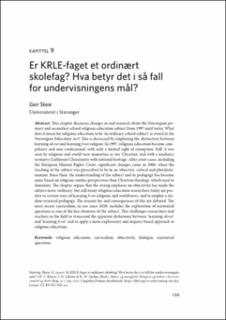| dc.contributor.author | Skeie, Geir | |
| dc.date.accessioned | 2023-03-14T10:24:58Z | |
| dc.date.available | 2023-03-14T10:24:58Z | |
| dc.date.created | 2022-02-24T09:15:49Z | |
| dc.date.issued | 2022 | |
| dc.identifier.citation | Skeie, G. (2022). Er KRLE-faget et ordinært skolefag? Hva betyr det i så fall for undervisningens mål. I: H. V. Kleive, J. G. Lillebø & K.-W. Sæther (Red.), Møter og mangfold: Religion og kultur i historie, samtid og skole. Cappelen Damm Akademisk, s. 199-227. | en_US |
| dc.identifier.isbn | 978-82-02-75389-4 | |
| dc.identifier.uri | https://hdl.handle.net/11250/3058110 | |
| dc.description.abstract | This chapter discusses changes in and research about the Norwegian primary and secondary school religious education subject from 1997 until today. What does it mean for religious education to be ‘an ordinary school subject’ as stated in the Norwegian Education Act? This is discussed by employing the distinction between learning about and learning from religion. In 1997, religious education became compulsory and non-confessional, with only a limited right of exemption. Still, it was seen by religious and world view minorities as too ‘Christian’ and with a tendency to marry (Lutheran) Christianity with national heritage. After court cases, including the European Human Rights Court, significant changes came in 2008, when the teaching of the subject was prescribed to be in an ‘objective, critical and pluralistic’ manner. Since then, the understanding of the subject and its pedagogy has become more based on religious studies perspectives than Christian theology, which used to dominate. The chapter argues that the strong emphasis on objectivity has made the subject more ‘ordinary’, but still many religious education researchers today are positive to certain ways of learning from religions and worldviews, and to employ a student-oriented pedagogy. The reasons for and consequences of this are debated. The most recent curriculum, in use since 2020, includes the exploration of existential questions as one of the key elements of the subject. This challenges researchers and teachers in the field to transcend the apparent dichotomy between ‘learning about’ and ‘learning from’ and to apply a more exploratory and inquiry-based approach to religious education. | en_US |
| dc.language.iso | mis | en_US |
| dc.publisher | Cappelen Damm | |
| dc.relation.ispartof | Møter og mangfold: Religion og kultur i historie, samtid og skole | |
| dc.rights | Navngivelse 4.0 Internasjonal | * |
| dc.rights.uri | http://creativecommons.org/licenses/by/4.0/deed.no | * |
| dc.title | Er KRLE-faget et ordinært skolefag? Hva betyr det i så fall for undervisningens mål? | en_US |
| dc.title.alternative | Er KRLE-faget et ordinært skolefag? Hva betyr det i så fall for undervisningens mål? | en_US |
| dc.type | Chapter | en_US |
| dc.description.version | publishedVersion | en_US |
| dc.rights.holder | The author | en_US |
| dc.subject.nsi | VDP::Samfunnsvitenskap: 200::Pedagogiske fag: 280 | en_US |
| dc.source.pagenumber | 199-227 | en_US |
| dc.identifier.doi | 10.23865/noasp.156.ch9 | |
| dc.identifier.cristin | 2005045 | |
| cristin.ispublished | true | |
| cristin.fulltext | original | |
| cristin.qualitycode | 1 | |

